
Product test
RingConn2 test: smaller, lighter but more powerful
by Lorenz Keller

Air is the name of the new version of the RingConn smart ring. However, savings have not been made on size and weight, but on price and features. Is the entry-level version a good alternative?
Welcome to the family! The second generation of the smart ring has got a little sister called RingConn Gen 2 Air. Unlike with people, a latecomer like this is often viewed critically in the world of gadgets. What is it supposed to do? What can it do? Does it even need it?
«Air» Many manufacturers call products that are more compact and lighter. However, the opposite is true for the airy ring: the Gen 2 Air is heavier than the Gen 2. In my size (ring size 11), the non-Air weighs 2.6 grams and the Air 3.5 grams. However, I don't notice this in everyday life.
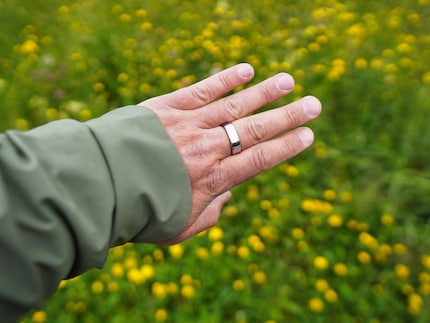
But I can see a visual difference: the Air looks slightly thicker and wider than the version already available. However, this is a deception, effectively both have the same dimensions, but a slightly different design. I still like the new and cheaper version. However, the Gen2 Air is only available in silver and gold, while the normal Gen2 is also available in black and rose gold.
After three weeks on my finger, my silver test ring had a few scratches on the underside - where I occasionally hit hard objects with the ring when I hold it in my hand. I don't mind a little patina, but tastes differ.
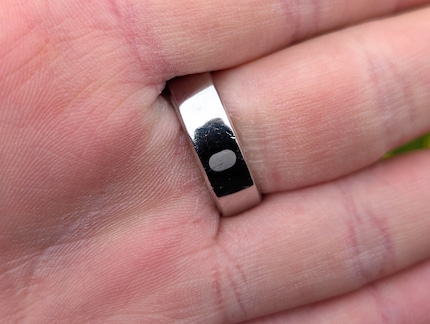
The fact that I see more marks than ever before on a ring is due to the light colour and the material used: The Air is made of stainless steel, while the normal Gen2 is made of a stronger titanium alloy.
I find differences between the two rings in two areas. With the Air, I have to do without apnoea detection. Only the more expensive Gen2 can measure breathing pauses at night. Otherwise, the functions and app are identical.
In the test, I had to charge the battery of the Gen 2 Air every ten days. This is an excellent value and better than many competitor products. The Samsung Galaxy Ring, for example, only lasted seven to eight days, while the Oura 4 lasted around seven and a half days.
Interesting.
Interestingly, the battery life of the Air tested is slightly better than that of the normal RingConn Gen 2 - although on paper it should last two days longer.
I can live with the lack of apnoea measurement because the battery life is above average. What I really missed in everyday use was the charging case. The Air version only comes with a charging cradle that you have to plug into the mains. The more expensive Gen2 comes with a case with a battery that can charge the ring several times and can be used for storage if you're not wearing the ring.
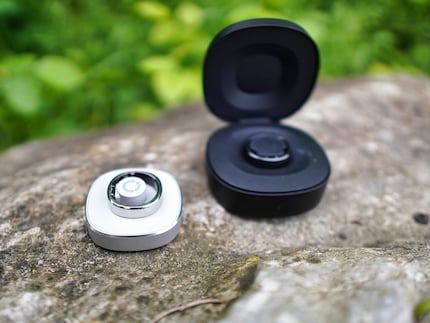
The big trump card of RingConn: you only have to buy the ring and don't have to take out an additional plan for the software. When testing the first generation a year ago, the tracking was less sophisticated than that of the competition. This has changed step by step.
Because the manufacturer is constantly expanding the functionality - without any obligation to subscribe to a plan. What has remained the same is that synchronisation between the app and Ring takes a relatively long time, which doesn't bother me as I look at the data two or three times a day.
The central element in the app is a cloverleaf symbol consisting of four values: sleep, relaxation status, vital signs status and activity. The four areas fill up over the course of the day and should be as balanced as possible. I can call up details on each of these areas with one click.
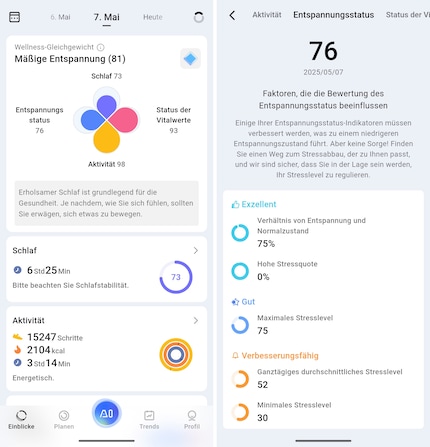
And it's amazing what the tracking recognises. For example, I don't feel fit for a few days, I'm impatient and things don't go the way I want them to. This quickly shows up in the relaxation status - for example with a high average stress level. I get a push notification from the ring that it has detected significant fluctuations in my vital functions.
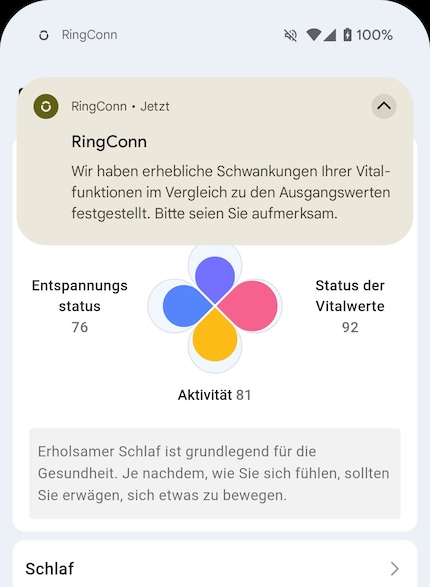
What good does that do me? The ring has only determined what I already know. That's true - but the tracking motivates me to take a closer look. And thanks to the data, I can see where I can start: On the one hand, I haven't slept enough - and poorly at that. On the other hand, I was never able to relax during the day. I can change both - and after two days I feel fit again.
The RingConn app still has a simple design and no bells and whistles. It is not particularly visually appealing, but it is very clear. The specific sports tracking is limited to the four areas of indoor and outdoor running, cycling and hiking.
The manufacturer is currently developing the AI chatbot further. So far, I can only ask predefined questions and receive short, concise answers. In future, I should be able to type in any text and receive more detailed answers. In the test version, for example, I had a detailed sleep analysis created for me.
I learnt that I don't sleep enough and, above all, don't have a regular rhythm - my sleep times vary greatly. My deep sleep and REM phases, on the other hand, are good. I now ask the AI what I should improve first: Duration or regularity. The answer is clear and detailed. I should fall asleep between 10.30 and 11.30 p.m., «to stabilise the sleep architecture». The app gives me the tip that sleeping in late at the weekend doesn't do much to compensate overall.
The AI assistant, which is currently only available to selected testers, is well made and a useful addition to the previous app. I can still decide for myself whether I want tips, tricks and analyses - or whether the pure data is enough for me.
As always with data protection, you have to trust the Chinese manufacturer. RingConn undertakes to only forward anonymised data to the AI model. Third-party providers are also not allowed to train the AI. Nevertheless, you should be aware that the data collected will be shared with the manufacturer and the AI supplier.
Cycle tracking, multi-day analysis and the search function for lost rings are also improved in app version 3.0.
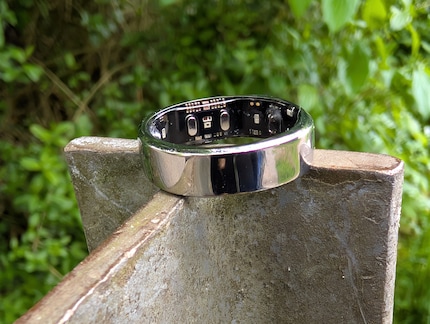
?
I find it impossible to answer this question precisely. When tested, the measurements seemed plausible - the bedtimes, for example, were correct.
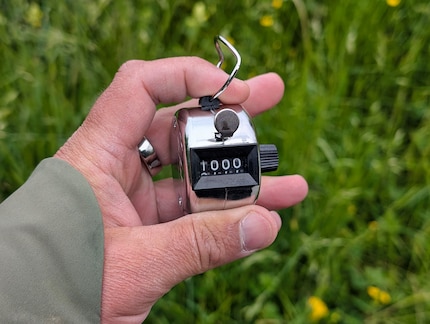
What I can check is the step measurement. I walked 1000 steps twice and counted them manually with a clicker. Like the other rings, the RingConn Gen 2 Air cuts a good figure. Overall, it is around 1.5 per cent too low. The RingConn Gen 2 and the Oura Ring 4 are slightly more accurate, while the Samsung Galaxy Ring fluctuates more. At least with the Air, I know that it doesn't suggest too much movement, but instead favours understatement.
The RingConn Gen 2 Air turns out not to be an unloved adopted child when tested, but an ideal addition to the Ring family. It is slightly cheaper than most other finger trackers that have come onto the market in recent weeks and months.
You save around 50 to 100 francs compared to the normal Gen 2, which is worth it if you like the two colours silver or gold and don't need apnoea tracking. However, you shouldn't be too sensitive to small scratches and imperfections.
So it is with children: every child is different - some a little more robust, some a little more needy of love. But they are all part of the family.
The RingConn Gen 2 Air is not lighter or smaller than the competition, but it is cheaper. Nevertheless, you don't have to do without any important functions. The tracking app is clearly laid out and offers all the essential information at a glance - but without overloaded graphics. However, you can also take a deep dive into the data at any time.
You have to make compromises in the selection. The ring is only available in two colours, and it is not made of a titanium alloy, but of the somewhat less robust stainless steel. The manufacturer has also skimped on the charging case. The ring comes with a normal charging station.
Pro
Contra
Gadgets are my passion - whether you need them for the home office, for the household, for sport and pleasure or for the smart home. Or, of course, for the big hobby next to the family, namely fishing.